
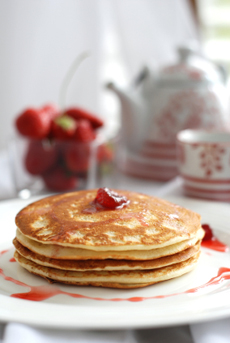
A pancake stack—here garnished with strawberry preserves—is comfort food. Photo by Elena Kor | IST.
September 2005
Last Updated October 2025
|
 |
Pancake & Waffle Glossary
Page 3: Terms Beginning With G To L
This is Page 3 of a six-page glossary of pancake and waffle types and terms. If you’d like to suggest additional words for inclusion, click here. Learn more about your other favorite foods in our 100+ food glossaries, including a Sugar & Syrup Glossary.
Click on a letter to get to the appropriate glossary page.
a b c d e f g h i j k l m n o p q r s t u v w x y z
This glossary is protected by copyright and cannot be reproduced in whole or in part.
GALETTE
A galette is a savory buckwheat crêpe, a type of pancake from Brittany. Unlike the crêpe, the galette is cooked on one side only. It is frequently garnished with meat, fish, cheese, salad, or similar ingredients. One of the most popular varieties is a galette covered with grated gruyère cheese, a slice of ham, and an egg, cooked on the galette. In France, this is known as a galette complète. A hot sausage wrapped in a galette (a galette-saucisse) and eaten like a hot dog is also becoming more and more popular. There is also an open-faced pie called a galette. See our Cake Glossary. |
|
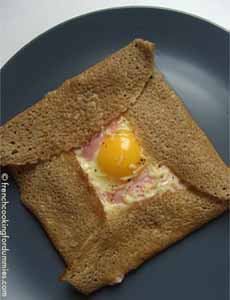
Buckwheat galette. Here’s the recipe (photo © French Cooking For Dummies). |
GERMAN PANCAKE
A German pancake is another term for a Dutch Baby pancake. It is also called a Bismarck, a Dutch puff, a Hooligan, and a Hootenanny. It is similar to a large English Yorkshire pudding.
Unlike most pancakes, German pancakes, Dutch Babies are baked in the oven, rather than being fried in a pan on the stovetop. See also pannekoeken, a Dutch pancake.
German/Dutch pancakes can be baked in any shape pan.
Here’s the recipe for the round German apple pancake below.
|
|
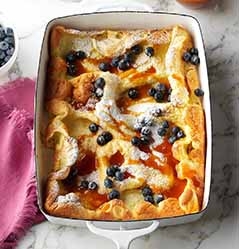
German pancake. Here’s the recipe (both photos © Taste Of Home). |
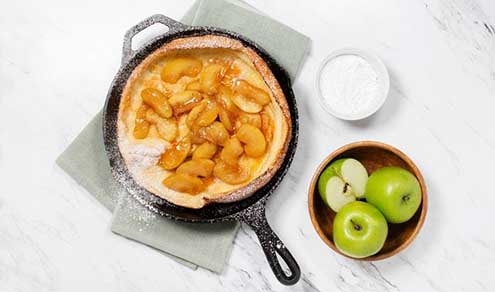
GRIDDLE
A flat, rimless metal pan used for cooking by dry heat. Griddles are often used to cook foods such as bacon, eggs, pancakes, and hamburger patties. A griddle can be square (above), round, or rectangular.
GRIDDLE CAKE
Another word for pancake.
HOTCAKE
See pancake.
|
|
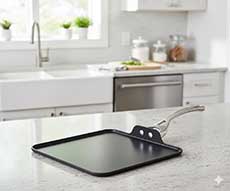
Calphalon nonstick griddle (Gemini photo).
Photo below: A double griddle (photo © AllClad). |
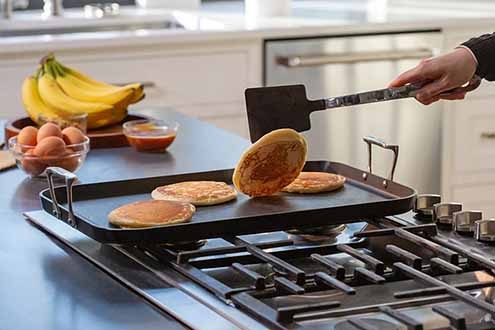
INJERA or ENJERA
Injera is a pancake-like bread made out of teff flour. It is traditionally eaten in Ethiopia, Somalia (where it is also called lahoh), and Eritrea. The flour is mixed with water and allowed to ferment for a few days. It is then ready to fry into large flat pancakes. A variety of stews, and sometimes salad, are placed upon the injera for serving; or, a piece can be torn off and used to scoop up food. Using one’s right hand, small pieces of injera are torn and used to grasp the stews and salads for eating. Injera is thus both food and plate at the same time.
|
|
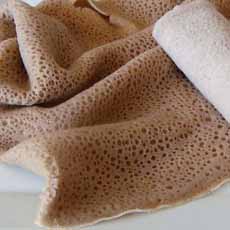
Looking like a spongy pancake, injera is a flatbread, used instead of utensils, to scoop up food (photo © Ethiopian Diamond Market). |
JAPANESE PANCAKE or JAPANESE SOUFFLÉ PANCAKE
Japanese pancakes, also called Japanese soufflé pancakes (okonomiyaki ), are thick pancakes that are made using souffle techniques. using soufflé techniques. Egg whites are whipped with sugar and then mixed with a batter made with egg yolks. The result is custardy on the inside and golden and crispy on the outside. They are cooked in ring molds to achieve the perfect roundness. Here’s a recipe.
|
|
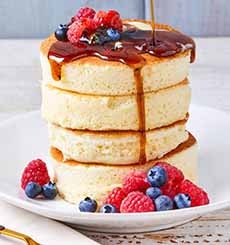
A stack of Japanese pancakes: light, fluffy, and extremely popular in Japan (photo © Thermomix). |
JOHNNYCAKE or JONNYCAKE
Not a pancake but cornmeal bread (cornbread), usually shaped into a flat cake and baked or fried on a griddle. Believed to be taught to the Pilgrims by the Native Americans, it became a staple in New England and the upper Midwest. Today, however, johnnycake is largely known in the South. It has many different regional names, including ashcake, batter bread; battercake, corn cake, corn pone, hoecake, journey cake, pone, and Shawnee cake.
|
|
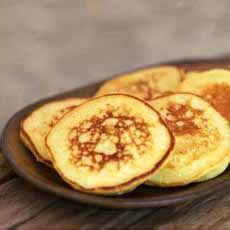
They look like pancakes, but johnnycakes are cornmeal bread (photo © Southern Food | Dot Dash). |
KOUIGN AMANN or KOUIGN AMAN
Kouign amann is a Breton cake. It is a galette, a kind of crêpe made with brioche dough, butter, and sugar. The name derives from the Breton words for cake, kouign, and butter, amann. Kouign amann is a specialty of the village of Douarnenez in Finistère, where it originated in 1865. Read our extensive explanation of kouign amann.
KRUMKAKE
A Norwegian pancake made in a decorative, two-sided press (the plates look like a circular, shallow waffle iron plate with an elaborate design instead of the waffle squares). The finished pancake is molded into a tube shape, allowed to harden, and then eaten plain or filled with whipped cream or other fillings, like a cannoli. Krumkake is a variation of the Italian pizzelle.
|
|
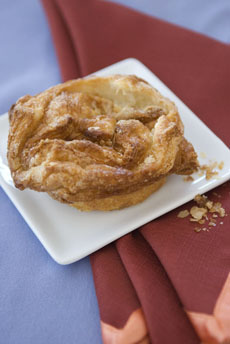
An individual kouign amann, a breakfast pastry from the Viennoiserie group that is as addictive in its way as a great coffee cake (photo by Corey Lugg | © THE NIBBLE). |
LEFSE
Lefse (pronounced lef-sa) is a traditional soft Norwegian potato crepe, made from potato, milk, and flour, and cooked on a griddle. There are significant regional variations in the way lefse is made and eaten, but it generally resembles a tortilla. In the middle part of Norway, a variation called tynnlefse (thin lefse) is made, which is rolled up with butter, sugar, and cinnamon, and eaten as a cake. Tjukklefse or tykklefse (thick lefse) is thicker and, again, often served over coffee as a cake. Potetlefse (potato lefse) is often used in place of a hot dog bun and can be used to roll up sausages. This delight is also known as pølse med lompe in Norway, lompe being the potato lefse.
|
|
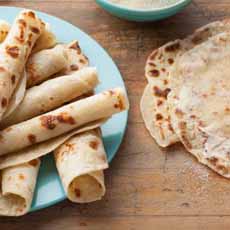
Lefse can be eaten like tortillas or rolled with a filling. In the U.S., they are popular in North Dakota, which has a large Norwegian-descended population. Here’s a recipe from Cooking Channel TV.
|
LIÈGE WAFFLE
The Liège waffle is the second major type of waffle eaten in Belgium, although it claims to be the “original waffle” with a 600-year history. It was invented by the chef of the prince-bishop of Liège, a city in eastern Belgium. While the Brussels waffle (which Americans know as the Belgian waffle) is a crisp dessert waffle, served with a sweet topping and eaten with a knife and fork, the Liège waffle is a smaller, handheld snack food in the manner of a donut. It has a yeast dough and is golden-yellow, softer, and denser in texture than the Brussels waffle, with a caramelized sugar coating from the last-minute addition of pearl sugar that provides a lightly sweet, distinctive flavor. It also has irregular edges, as opposed to the Brussels waffle, which is perfectly rectangular or square with even sides. The Liège waffle is sold by street vendors and at bake shops all over Belgium.
|
|
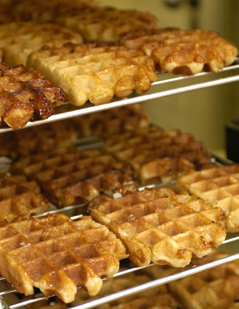
Liège waffles (photo © copyright the Belgian Tourist Office NYC/USA, VisitBelgium.com). |
Continue To Page 4: Terms Beginning With M & O
Go To The Alphabet Index Above
Some information in this glossary is courtesy of Wikipedia, the free encyclopedia.

|















